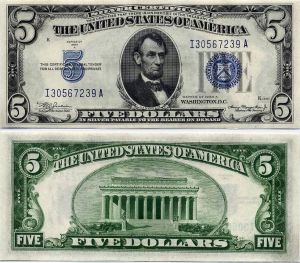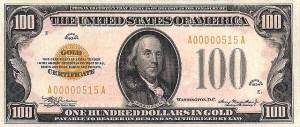Money is primarily a medium of exchange or means of exchange. It is a way for a person to trade what he has for what he wants. Ideal money has three critical characteristics: it acts as a medium of exchange; it is an economic good; and it is a means of economic calculation.
Medium of Exchange
To properly understand money as a medium of exchange one must first go back to the first methods of trade. Before money was invented one would have to engage in direct barter. A farmer who produced grain – but wanted shoes for his family – would have to find someone who, a) had shoes and, b) wanted grain. You can imagine the difficulty involved in finding that perfect someone who had what the farmer wanted and wanted what the farmer had.
Out of necessity, this gave rise to indirect barter. Continuing with our example above, let’s assume that the farmer found a shoemaker but discovered that the shoemaker did not want grain – he wanted candlesticks. While having a drink at the local pub he overheard the gentleman next to him lamenting that he needed grain in exchange for his candlesticks. Naturally, the farmer traded his grain for the candlesticks and went back to the shoemaker and traded the candlesticks for shoes. In this example, the farmer performed indirect barter when he used the candlesticks as a medium of exchange.
Economic Good
Over time, different commodities served as medium of exchange but the problem of marketability and durability came into play. A necessary and highly exchangeable commodity was food. The problem is that it was perishable. One had to either use it or trade it before it went bad.
Economic Calculation
Money is an expression of exchange value (the exchange values placed on goods by traders in the marketplace). In our examples above, it was extremely inefficient to express the exchange value of goods in units of sacks of grain, shoes, or candlesticks. Out of necessity the market gravitated toward the use of the exchange value of fixed weights of gold and silver. As an example, the original U.S. Silver Dollar was modeled after the Spanish Dollar which had a specific weight of silver (371 4/16th grains of pure silver or 416 grains of standard silver). A simple method of economic calculation consisting of weights and measures greatly improved trade and fostered economic growth.
What is the best form of money?
In actuality, the best approach is to let the people (the free market) decide what they want to use as money. There is no need for a central bank, government control, or legal tender laws. Good money has:
1. scarcity – supply cannot be manipulated like fiat money which causes the boom and bust cycles in the economy
2. durability – how well will it hold up and how long will it last?
3. fungible and divisible – they can be divided into small, interchangeable amounts which make them ideal for trade.
4. portable and defensible – Their high concentration of value allows you
to carry, store and protect substantial value. Ability to transfer value across space and time efficiently and cheaply is a key feature of good money.
5. utility/demand – does it perform the role of money well? Does it have any other uses? Other uses are beneficial but not necessary if it performs all the other roles role of money well.
Purchasing Power Can Rise Over Time with Honest Money
Honest Money (defined as a medium of exchange consisting of real goods that are in limited supply) can actually increase in value over time. Let me explain. When the production of other economic goods grows at a faster rate than the supply of money (mined gold or bitcoin for example) the money can buy (be traded for) more of these other goods (money supply divided by the total number of goods). This means that it could actually pay to save your money because it can increase in exchange value over time. This also means that nominal wages could decrease over time while real wages increase (your paycheck “amount” drops but your purchasing power increases).
Why and how did Government Money supplant Gold and Silver?
The first bankers were the goldsmiths. Miners would bring the gold to the goldsmiths for minting. The goldsmith would give the miner a receipt that he could redeem when the minting was completed. The miner soon found that he could immediately trade his receipt (his claim on the gold) for tools and supplies and return to the mines without having to wait for his gold.
Over time, the goldsmith found that the receipts he issued stayed in circulation and were being used as medium of exchange. Only a small percentage of the people ever came in to redeem the receipts. To increase his purchasing power he simply began to issue his own fraudulent receipts (that had no gold backing) and used them to acquire goods and services. This increase in the number of outstanding receipts created inflation and lessened the value of all of the other outstanding receipts.
In later days, central banks did the same thing. They issued more receipts (paper currency) than they had the gold and silver to back it. The U.S. paper currency was originally a receipt for gold or silver. Take a look at the five dollar silver certificate below. Notice the words “This certifies that there is on deposit in the treasury of the United States of America five dollars in silver payable to the bearer on demand.”
In March 1964, Secretary of the Treasury C. Douglas Dillon halted redemption of Silver Certificates for Silver Dollars effectively breaking the contractual terms of the Silver Certificates.
Here is an image of a Gold Certificate:
From Wikipedia:
The gold certificate was used from 1882 to 1933 in the United States as a form of paper currency. Each certificate gave its holder title to its corresponding amount of gold coin. Therefore, this type of paper currency was intended to represent actual gold coinage. In 1933 the practice of redeeming these notes for gold coins was ended by the U.S. government and until 1964 it was actually illegal to possess these notes (in 1964 these restrictions were lifted, primarily to allow collectors to own examples legally, however the issue technically converted to standard ‘legal tender’ with no connection to gold). When U.S. paper money was modernized (made smaller, with fewer variations or “types”, as with current paper money) in 1928, gold certificates ceased to be issued.
In essence, the central bankers reneged on their promise to honor their warehouse receipts and effectively stole the gold and silver that was owed to the populace. It was laziness on the part of the populace to blindly trust the central bankers with their money and deceit on the part of the central bankers when they reneged on their promises. The central bankers were now able to expand and contract the supply of money (nonredeemable certificates) to exert their power and influence over the populace.
The market always decides what is the best form of money. In fact, it is deciding right now – despite government intervention. Good old-fashioned barter is still alive and strong.
A Modern-Day Money Alternative:



Pingback: Understanding Money | THE WORLD IS NOT READY
Pingback: Further Observations on Bitcoin, Digital Currencies, Privacy and Liberty | The Freedom School
Pingback: Further Observations on Bitcoin, Digital Currencies, Privacy and Liberty « Keep Your Assets
Pingback: Como explicar o que é o dinheiro para uma criança de 10 anos. | Bitcoin Revolution
Yes, this explains why you feel bitcoin would profit from deflation.
Here’s a discussion I had with the Daily Bell people on the matter of circulation in a free market: Gresham’s Law says that the units DEPRECIATING faster will be payed with.
So if you have Gold and Federal Reserve Notes circulating side by side, people will pay with the paper and hoard the gold. That’s easy to establish, just check what you would pay with yourself.
Here’s the article:
See: Bitcoin and the Virtue of Hoarding and Deflation http://tinyurl.com/6r8w7xk
Pingback: Further Observations on Bitcoin, Digital Currencies, Privacy and Liberty | Economics and Liberty
On my side its good and nice explanation ever cause I didn’t know about this history of money.
money is a medium of exchange that is accepted for the payment of dept,goods and services.
I love that so much. keep lnforming
Great article. I made this video on the same topic. What do you think? https://monchilla.zendesk.com/hc/en-us/articles/202088138-What-is-money-
Money is anything which is general accepted by a society as a medium of exchange with recognition something of value to be exchanged whether goods or services for payment.
l like economics
If u set your eye on flamboyancy, ur heading to instruction.
What is regoncibility & homogenity?
Great research
So helpful to us student.
I DON’T KNOW THAT THEIR IS HISTORY OF MONEY BUT NOW IT WAS NOW CLARE TO ME THAT MONEY IS AN EXPRESSION VALUES PLACED ON GOODS BY TRADERS .
In my opinion, money is just a tools to exchange you needs with something you already have. Money is necessary to buy groceries four your daily needs but it’s not the most important thing in life… The best way to make money is by using the money itself, MONEY ATTRACTS MORE MONEY… 🙂
I support your views but at this time we can’t do anything without money. I see many people who beg to eat something . so I think thatoney is most important in life
Nice
Money rules
with money evry thing sorpose to be essy but the is still money and things are hard
Nice explanition
what a great explanation of money and how its come to be.
Yes
Pingback: SPDR Gold Trust ETF: Gold to $10,000? | ETF DAILY NEWS
If u set your eye on flamboyancy, ur heading to instruction.
why not Nigerian government seek on how to make sure they currency have value, they print high note so that they can part it as much, we need the value of naira to go up
I am more enlightened on this subject. I want to say a big thank you.
YOU GUYS ARE MEANT TO INCLUDE THE QUALITIES OF A GOOD MONEY(KUDI,EGO,OWO)BUT U PEOPLE HAVE DON A GUD JOB
I m understanding but
Who wrote this
Pingback: What is Money? – Bitcoin Investor
Pingback: A Short History of Money: From Commodities to Fiat to Cryptocurrencies & Digital Wallets – Blockchains.MY
Is money a liability or a claim or both..?